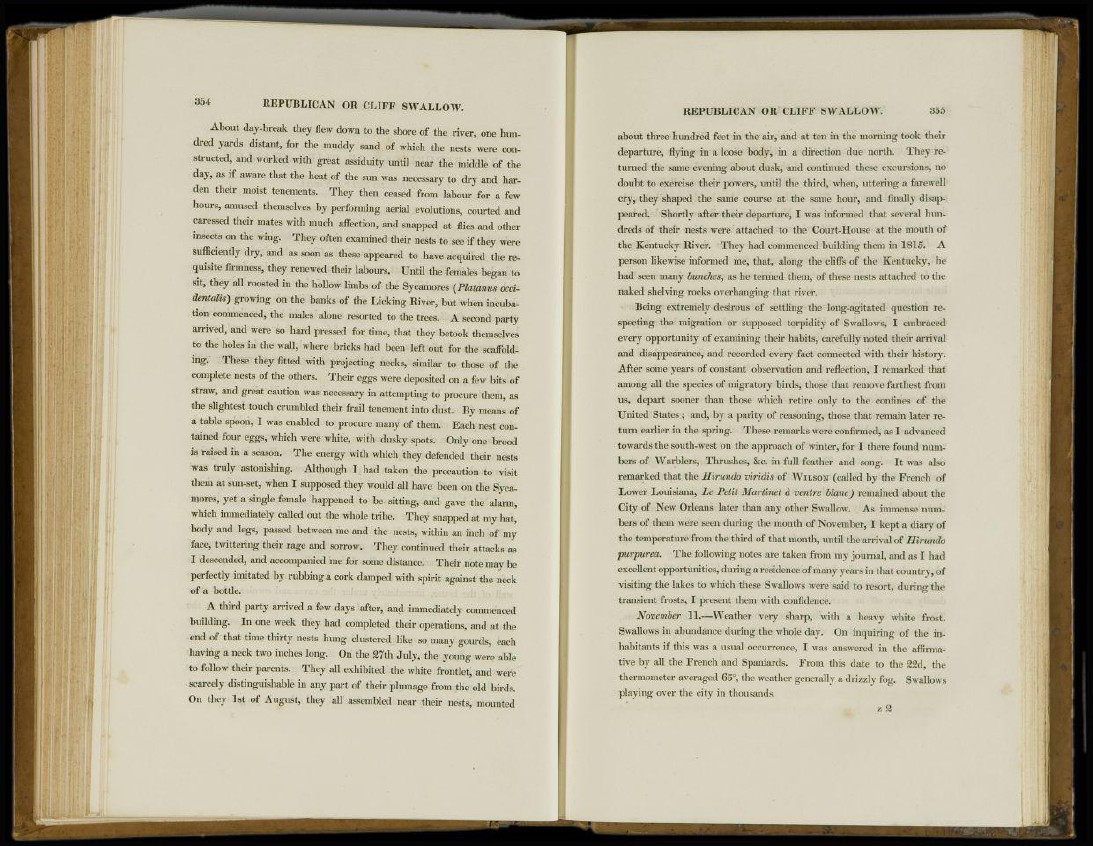
354 REPUBLICAN OR CLIFF SWALLOW.
About day-break they flew down to the shore of the river, one hundred
yards distant, for the muddy sand of which the nests were constructed,
and worked with great assiduity until near the middle of the
day, as if aware that the heat of the sun was necessary to dry and harden
their moist tenements. They then ceased from labour for a few
hours, amused themselves by performing aerial evolutions, courted and
caressed their mates with much affection, and snapped at flies and other
insects on the wing. They often examined their nests to see if they were
sufficiently dry, and as soon as these appeared to have acquired the requisite
firmness, they renewed their labours. Until the females began to
sit, they all roosted in the hollow limbs of the Sycamores (Platanus occidentalis)
growing on the banks of the Licking River, but when incubation
commenced, the males alone resorted to the trees. A second party
arrived, and were so hard pressed for time, that they betook themselves
to the holes in the wall, where bricks had been left out for the scaffolding.
These they fitted with projecting necks, similar to those of the
complete nests of the others. Their eggs were deposited on a few bits of
straw, and great caution was necessary in attempting to procure them, as
the slightest touch crumbled their frail tenement into dust. By means of
a table spoon, I was enabled to procure many of them. Each nest contained
four eggs, which were white, with dusky spots. Only one brood
is raised in a season. The energy with which they defended their nests
was truly astonishing. Although I had taken the precaution to visit
them at sun-set, when I supposed they would all have been on the Sycamores,
yet a single female happened to be sitting, and gave the alarm,
which immediately called out the whole tribe. They snapped at my hat,
body and legs, passed between me and the nests, within an inch of my
face, twittering their rage and sorrow. They continued their attacks as
I descended, and accompanied me for some distance. Their note may be
perfectly imitated by rubbing a cork damped with spirit against the neck
of a bottle.
A third party arrived a few days after, and immediately commenced
building. In one week they had completed their operations, and at the
end of that time thirty nests hung clustered like so many gourds, each
having a neck two inches long. On the 27th July, the young were able
to follow their parents. They all exhibited the white frontlet, and were
scarcely distinguishable in any part of their plumage from the old birds.
On they 1st of August, they all assembled near their nests, mounted
REPUBLICAN OR CLIFF SWALLOW. 355
about three hundred feet in the air, and at ten in the morning took their
departure, flying in a loose body, in a direction due north. They returned
the same evening about dusk, and continued these excursions, no
doubt to exercise their powers, until the third, when, uttering a farewell
cry, they shaped the same course at the same hour, and finally disappeared.
Shortly after their departure, I was informed that several hundreds
of their nests were attached to the Court-House at the mouth of
the Kentucky River. They had commenced building them in 1815. A
person likewise informed me, that, along the cliffs of the Kentucky, he
had seen many bunches, as he termed them, of these nests attached to the
naked shelving rocks overhanging that river.
Being extremely desirous of settling the long-agitated question respecting
the migration or supposed torpidity of Swallows, I embraced
every opportunity of examining their habits, carefully noted their arrival
and disappearance, and recorded every fact connected with their history.
After some years of constant observation and reflection, I remarked that
among all the species of migratory birds, those that remove farthest from
us, depart sooner than those which retire only to the confines of the
United States; and, by a parity of reasoning, those that remain later return
earlier in the spring. These remarks were confirmed, as I advanced
towards the south-west on the approach of winter, for I there found numbers
of Warblers, Thrushes, &c. in full feather and song. It was also
remarked that the Hirundo viridis of W I L S O N (called by the French of
Lower Louisiana, Le Petit Martinet a ventre blanc) remained about the
City of New Orleans later than any other Swallow. As immense numbers
of them were seen during the month of November, I kept a diary of
the temperature from the third of that month, until the arrival of Hirundo
purpurea. The following notes are taken from my journal, and as I had
excellent opportunities, during a residence of many years in that country, of
visiting the lakes to which these Swallows were said to resort, during the
transient frosts, I present them with confidence.
November 11.—Weather very sharp, with a heavy white frost.
Swallows in abundance during the whole day. On inquiring of the inhabitants
if this was a usual occurrence, I was answered in the affirmative
by all the French and Spaniards. From this date to the 22d, the
thermometer averaged 65°, the weather generally a drizzly fog. Swallows
playing over the city in thousands.
z 2